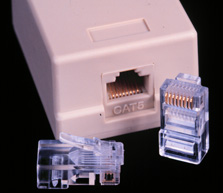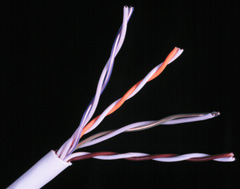Communications Wiring For Today's Homes
Copper Applications in Electronic & Communications
Introduction
The connectivity demands of today's computers and other electronic devices are rapidly overwhelming the capabilities of the standard telephone wiring found in most homes. To handle these new demands houses and other residential structures are starting to be wired with the cable used for computer networking, called Category 5 (Cat 5) cable. This type of cable has the ability to handle tremendous amounts of data and simultaneously allow many devices to operate over the same cable. New copper based cabling coming onto the market has sufficient capacity to handle video and other data intensive applications and should be sufficient to residential data needs for the foreseeable future.
The Problem
Today's and tomorrow's homeowners expect their homes to accommodate:
- Multiple phone lines
- Internet service
- Home automation
- Video distribution, and other entertainment services
- Data and security services
- Fax machines
- . . .
Standard phone wiring requires a separate line to be run for each of these services and is incapable of handling those needs that require moving large quantities of data. In addition, the wiring is typically from one or a small number of rooms to the outside making it difficult to move equipment from room to room.
As time passes these problems will become more severe. Counter intuitively, the problem is worse for homeowners than for businesses. This is because offices get extensively remodeled, and rewired, every few years. Homes do not. The wiring that is installed when the home is built must serve indefinitely or be upgraded at a relatively high cost.
High Capacity Copper Wiring
Virtually all offices today use Category 5 cabling for their internal networks. Category 5 cable has sufficient capacity to handle the needs of almost all offices and the high cost of fiber components (network cards, etc.) makes it uneconomical for the vast majority of offices.
 In fact, most offices (including the one where this article was written) use 10BaseT networking equipment, which only makes use of 10% of the capability of Category 5 cabling. 10BaseT components can handle at most 10 megabits per second while Category 5 cable can handle 100 megabits per second. 100BaseT networking equipment, which is designed to handle 100 megabits per second using Category 5 cable, is only now starting to take a large share of the network equipment market.
In fact, most offices (including the one where this article was written) use 10BaseT networking equipment, which only makes use of 10% of the capability of Category 5 cabling. 10BaseT components can handle at most 10 megabits per second while Category 5 cable can handle 100 megabits per second. 100BaseT networking equipment, which is designed to handle 100 megabits per second using Category 5 cable, is only now starting to take a large share of the network equipment market.
Category 5 is the current standard, but it will soon be supplanted by even higher-speed versions, known as Levels 6 and 7. (Level 7 has more than twice the bandwidth, or information-carrying capacity, of Cat 5, at a small cost premium.) The Anixter levels article in this issue discusses these new cables.

The only area where Cat 5 cable may not be adequate for home use is ideo. This is because it is difficult to predict whether many channels - well over 100, for example - may become a reality in the near future, some channels of which will be the more bandwidth-consuming high-definition television (HDTV). The industry is working toward an all-UTP solution for wiring residences. At this time however, it may be prudent to also include conventional coaxial cable for video distribution, particularly cable TV.
Networking Your Home
In addition to its greater bandwidth, Category 5 cable allows multiple pieces of equipment to use the same cable at the same time. By wiring every room in a "star" pattern a home in effect has an internal network. This allows any piece of equipment to be set up in any room, or moved from room to room, without rewiring. Anyone who has moved an office from one room in a house to another will see the benefits of this.
With star wiring, each outlet (jack) has its own individual "home run" of cabling extending back to a central distribution device. There are two major advantages to this:
1) flexibility - all changes in distribution of services (TV, data, voice, etc.) take place at the distribution device. Each outlet can be treated independently from all others. (In loop wiring, that is, where a number of outlets are tied together in series, outlets cannot be treated independently.)
2) isolation of problems - when an interruption takes place (nail through a wall and into a cable, etc.) only that outlet is affected.
Copper UTP Wiring
What is it? Copper unshielded twisted pair (UTP) wiring contains eight color-coded conductors (four twisted pairs of copper wires). It offers greatly increased bandwidth, or information-carrying capacity, compared with old-fashioned quad wiring.
The cable is small (roughly 3/16 inch in diameter), inexpensive and easy to pull, although it must be handled with care.
Advantages
Modern copper UTP wiring offers the following advantages:
- Diversity. Cable TV and other entertainment signals, Internet and computer communications, as well as ordinary phone signals - all can be carried throughout the home on modern, inexpensive, high-speed, UTP cables.
- More phone numbers. More phone numbers can be made available throughout the house. Actually, voice service requires very little bandwidth, and the addition of separate numbers is almost trivial.
- Bandwidth. Cat 5 has a bandwidth of 80 MHz (megahertz), while Level 6 is 100 MHz and Level 7 is 180 MHz, when tested under stringent conditions. Note that this is many orders of magnitude greater than the bandwidth - which correlates with the speed - of the "modern" 56 kbps (kilobits per second) modem. Level 7 wiring, with encoding, will be able to carry at least 1 gigabit (billion bits) per second. If you're counting, that's about 50,000 pages of text per second.
- New Services. The Internet will soon be available at high speed to many homes via ADSL and cable and satellite modems, but homeowners won't be able to take advantage of it if their wiring is inadequate. Will the information highway end in a cowpath?
- Reliability. Interference on telecommunications lines can result in scrambled faxes, interrupted on-line sessions and distorted video and audio signals. High-tech twisted-pair copper wiring is designed to resist interference from sources in the home, such as microwave ovens, vacuum cleaners, fluorescent lights, power tools, other appliances and external communications signals. The tight, accurate twist of the wire pairs, and their balanced mode of transmission, are the reasons.
- Approved. Performance of these cables is certified by Underwriters Laboratories (UL), the international product testing agency, as well as by such industry leaders as Anixter.
Conclusion
It is clear that in the future homes will require sophisticated, high capacity data networks to handle their residents' computing, security, and entertainment needs. Once a home is built rewiring becomes very expensive. Inexpensive cabling systems can be installed today which can handle a home's data needs for the foreseeable future.
Also in this Issue:
- Home Automation Comes of Age: The Future Has Finally Arrived!
- Category 5: How Did We Get Here and Where Do We Go Next?
- xDSL Glossary
- xDSL Technology and The Internet (Part I)
- Communications Wiring For Today's Homes
- Best of Both Worlds: Helping to Create a Good Environment to do Business
